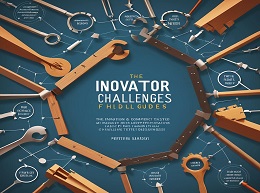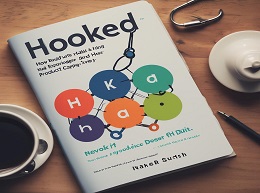The Innovator’s Field Guide: Market Tested Methods and Frameworks to Help You Meet Your Innovation

Master Innovation with "The Innovator’s Field Guide": A Comprehensive Review
Innovation is a vital component of business success, but navigating the path to effective innovation can be challenging. "The Innovator’s Field Guide: Market Tested Methods and Frameworks to Help You Meet Your Innovation Challenges" by Peter Skarzynski and David W. Crosswhite offers a comprehensive toolkit for overcoming these challenges. This review explores the book’s key insights, practical examples, and valuable frameworks that can transform the way organizations approach innovation.
About the Authors
Peter Skarzynski and David W. Crosswhite bring extensive experience to this guide. Skarzynski is a founding partner of ITC Business Group and a recognized thought leader in innovation strategy. Crosswhite, an experienced consultant, has helped numerous organizations implement successful innovation strategies. Their combined expertise ensures that the book is rich with practical advice grounded in real-world experience.
The Structure of the Book
"The Innovator’s Field Guide" is designed as a practical manual, divided into two main parts:
1. Foundations of Innovation : This section lays the groundwork for understanding the principles and practices of successful innovation.
2. Innovation Methods and Frameworks : The second part provides detailed, actionable methods and frameworks that can be applied to various innovation challenges.
Part 1: Foundations of Innovation
The book begins by defining what innovation truly means in a business context. Skarzynski and Crosswhite emphasize that innovation is not just about new products, but also about new business models, processes, and customer experiences. This broad perspective helps readers appreciate the multifaceted nature of innovation.
Example: Apple’s Ecosystem Innovation
Apple’s success is often attributed to its product innovations, such as the iPhone. However, Skarzynski and Crosswhite highlight Apple’s ecosystem innovation as equally critical. By creating a seamless integration between hardware, software, and services, Apple has built a powerful and enduring competitive advantage. This example illustrates how innovation can extend beyond products to encompass entire business models.
The Innovation Framework
The authors introduce a structured framework for innovation, which includes:
- Discovering Opportunities : Identifying unmet needs and emerging trends.
- Designing Solutions : Creating innovative solutions to address identified opportunities.
- Delivering Value : Implementing solutions effectively to generate value.
Part 2: Innovation Methods and Frameworks
The second part of the book is a treasure trove of methods and frameworks, each designed to tackle specific aspects of the innovation process. Skarzynski and Crosswhite provide detailed descriptions and step-by-step guides for each method, making them accessible and practical for readers.
Method 1: Customer-Centered Innovation
One of the key methods discussed is customer-centered innovation, which focuses on understanding and addressing the needs of customers. The authors argue that successful innovation starts with a deep understanding of the customer’s pain points and desires.
Example: Procter & Gamble’s Connect + Develop Program
Procter & Gamble (P&G) revolutionized its innovation approach with the Connect + Develop program, which leverages external collaborations to drive innovation. By actively seeking input and ideas from customers, suppliers, and even competitors, P&G has significantly enhanced its product development process. This example underscores the importance of involving customers in the innovation journey.
Method 2: The Business Model Canvas
The Business Model Canvas, developed by Alexander Osterwalder, is another essential tool highlighted in the book. This framework helps organizations map out their business model components and identify areas for innovation.
Example: Airbnb’s Disruptive Business Model
Airbnb disrupted the hospitality industry by rethinking the traditional business model. Instead of owning properties, Airbnb created a platform that connects homeowners with travelers. The Business Model Canvas can help other companies identify similar opportunities for disruptive innovation by examining key components such as value propositions, customer segments, and revenue streams.
Method 3: Rapid Prototyping
Rapid prototyping is a method that encourages quick development and testing of new ideas. This approach helps organizations validate concepts early in the innovation process, reducing the risk of costly failures.
Example: Google’s Design Sprint
Google’s Design Sprint methodology is a prime example of rapid prototyping in action. This five-day process involves ideation, prototyping, and testing with real users. By rapidly iterating on ideas, Google teams can quickly identify what works and what doesn’t, allowing them to refine their innovations efficiently.
Practical Insights and Takeaways
Throughout the book, Skarzynski and Crosswhite offer numerous practical insights and tips that can be immediately applied to real-world innovation challenges. Some key takeaways include:
- Start with the Customer : Innovation should always begin with a deep understanding of the customer’s needs and pain points.
- Experiment and Iterate : Use methods like rapid prototyping to quickly test and refine ideas.
- Leverage External Ideas : Embrace open innovation by collaborating with external partners and stakeholders.
- Align with Strategy : Ensure that innovation efforts are aligned with the overall business strategy to maximize impact.
- Create a Culture of Innovation : Foster an organizational culture that encourages creativity, experimentation, and risk-taking.
"The Innovator’s Field Guide" is an invaluable resource for anyone involved in the innovation process, from executives and managers to entrepreneurs and consultants. Peter Skarzynski and David W. Crosswhite provide a comprehensive, practical guide that demystifies innovation and offers concrete methods for achieving success.
The book’s combination of theoretical foundations, detailed frameworks, and real-world examples makes it a must-read for those looking to navigate the complex landscape of innovation. By following the methods and insights presented in this guide, organizations can effectively meet their innovation challenges and drive sustained growth.
Whether you’re looking to develop new products, create innovative business models, or enhance customer experiences, "The Innovator’s Field Guide" equips you with the tools and knowledge needed to succeed in today’s competitive market.













